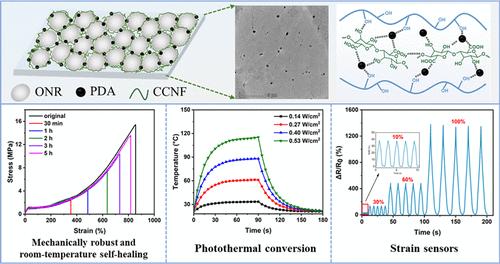Mechanically Robust and Room-Temperature Self-Healing Biobased Conductive Elastomers with Polydopamine-Functionalized Segregated Structure
IF 5.2
1区 化学
Q1 POLYMER SCIENCE
引用次数: 0
Abstract
Conductive elastomers integrating robust mechanical properties and room-temperature self-healing capability present great potential for advanced technologies, yet their fabrication remains challenging due to the inherent trade-off between strength and reparability, coupled with inadequate interfacial adhesion. We propose an innovative “one-stone-three-birds” strategy to address these challenges by developing supramolecular elastomer composites (SECs) through the incorporation of polydopamine (PDA) into a carboxylated cellulose nanofiber (CCNF)-reinforced oxidized natural rubber (ONR) system. The composite features a segregated architecture, where the ONR matrix is compartmentalized by the CCNF network with PDA localized within the CCNF phase. This strategic integration yields three major benefits: First, PDA enhances interfacial interactions between the ONR and CCNF, boosting mechanical robustness (15.33 MPa tensile strength, 834% elongation) while enabling remarkable ambient self-healing efficiency (87.5% recovery). Second, PDA’s excellent photothermal conversion facilitates light-activated, precise, and rapid self-healing and provides the SECs with promising thermoelectric properties. Third, PDA’s inherent adhesiveness allows for easy dip-coating of conductive materials onto the SECs surface to endow conductivity, resulting in flexible strain sensors with excellent sensitivity, reliability, and durability. Our innovative approach establishes a new paradigm in self-healing material design through molecular-level interfacial engineering and hierarchical structure control, simultaneously addressing critical challenges in mechanical robustness, dynamic reparability, and functional adaptability.

具有聚多巴胺功能化分离结构的室温自修复生物基导电弹性体
导电弹性体集成了强大的机械性能和室温自愈能力,为先进技术提供了巨大的潜力,但由于强度和可修复性之间固有的权衡,加上界面粘附不足,它们的制造仍然具有挑战性。我们提出了一种创新的“一石三鸟”策略,通过将聚多巴胺(PDA)掺入羧化纤维素纳米纤维(CCNF)增强氧化天然橡胶(ONR)体系中,开发超分子弹性体复合材料(SECs)来解决这些挑战。该组合具有分离的体系结构,其中ONR矩阵由CCNF网络划分,PDA定位在CCNF阶段。这种战略整合有三个主要好处:首先,PDA增强了ONR和CCNF之间的界面相互作用,提高了机械鲁棒性(15.33 MPa抗拉强度,834%伸长率),同时实现了显著的环境自愈效率(87.5%的恢复率)。其次,PDA出色的光热转换促进了光激活,精确和快速的自愈,并为sec提供了有前途的热电性能。第三,PDA固有的粘附性允许将导电材料很容易地涂在sec表面以赋予导电性,从而产生具有优异灵敏度,可靠性和耐用性的柔性应变传感器。我们的创新方法通过分子级界面工程和分层结构控制建立了自修复材料设计的新范式,同时解决了机械稳健性,动态可修复性和功能适应性方面的关键挑战。
本文章由计算机程序翻译,如有差异,请以英文原文为准。
求助全文
约1分钟内获得全文
求助全文
来源期刊

Macromolecules
工程技术-高分子科学
CiteScore
9.30
自引率
16.40%
发文量
942
审稿时长
2 months
期刊介绍:
Macromolecules publishes original, fundamental, and impactful research on all aspects of polymer science. Topics of interest include synthesis (e.g., controlled polymerizations, polymerization catalysis, post polymerization modification, new monomer structures and polymer architectures, and polymerization mechanisms/kinetics analysis); phase behavior, thermodynamics, dynamic, and ordering/disordering phenomena (e.g., self-assembly, gelation, crystallization, solution/melt/solid-state characteristics); structure and properties (e.g., mechanical and rheological properties, surface/interfacial characteristics, electronic and transport properties); new state of the art characterization (e.g., spectroscopy, scattering, microscopy, rheology), simulation (e.g., Monte Carlo, molecular dynamics, multi-scale/coarse-grained modeling), and theoretical methods. Renewable/sustainable polymers, polymer networks, responsive polymers, electro-, magneto- and opto-active macromolecules, inorganic polymers, charge-transporting polymers (ion-containing, semiconducting, and conducting), nanostructured polymers, and polymer composites are also of interest. Typical papers published in Macromolecules showcase important and innovative concepts, experimental methods/observations, and theoretical/computational approaches that demonstrate a fundamental advance in the understanding of polymers.
 求助内容:
求助内容: 应助结果提醒方式:
应助结果提醒方式:


